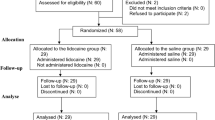Abstract
Purpose
The purpose of this study was to determine whether intraoperative infusion of remifentanil induces acute tolerance to opioids, and compare the postoperative pain and opioid consumption by the effect site concentrations of remifentanil.
Methods
One hundred and ninety-eight patients undergoing gastrectomy were randomly assigned to maintain target effect site concentrations of remifentanil at 0 (Group 1, n = 39), 2 (Group 2, n = 40), 4 (Group 3, n = 39), 8 (Group 4, n = 40), or 12 ng/ml (Group 5, n = 40) during operation. Postoperative pain intensities and fentanyl requirement were recorded at postoperative 2, 6, 24, and 48 h.
Results
Fentanyl requirement for postoperative 2 h was significantly greater in Group 5 compared to Group 1 (376 ± 116 vs. 283 ± 129 µg, P = 0.03). However, there were no differences in fentanyl requirements among the groups after postoperative 2 h. Also, total fentanyl consumption for 48 h was similar in all groups (Group 1; 3106 ± 629, Group 2; 2970 ± 705, Group 3; 3017 ± 555, Group 4; 3151 ± 606, and Group 5; 2984 ± 443 µg, P = 0.717). Pain scores at rest and during deep breathing were comparable in all groups at the time of each examination.
Conclusion
Intraoperative infusion of remifentanil with 12 ng/ml of effect site concentration in patients undergoing gastrectomy increases early postoperative fentanyl requirement. Acute opioid tolerance would be developed by higher concentration of remifentanil than dosage of common anesthetic practice.


Similar content being viewed by others
References
Colvin LA, Fallon MT. Opioid-induced hyperalgesia: a clinical challenge. Br J Anaesth. 2010;104:125–7.
Minville V, Fourcade O, Girolami JP, Tack I. Opioid-induced hyperalgesia in a mice model of orthopaedic pain: preventive effect of ketamine. Br J Anaesth. 2010;104:231–8.
Chu LF, Angst MS, Clark D. Opioid-induced hyperalgesia in humans: molecular mechanisms and clinical considerations. Clin J Pain. 2008;24:479–96.
Silverman SM. Opioid induced hyperalgesia: clinical implications for the pain practitioner. Pain physician. 2009;12:679–84.
Cabanero D, Campillo A, Celerier E, Romero A, Puig MM. Pronociceptive effects of remifentanil in a mouse model of postsurgical pain: effect of a second surgery. Anesthesiology. 2009;111:1334–45.
Guignard B, Bossard AE, Coste C, Sessler DI, Lebrault C, Alfonsi P, Fletcher D, Chauvin M. Acute opioid tolerance: intraoperative remifentanil increases postoperative pain and morphine requirement. Anesthesiology. 2000;93:409–17.
Kissin I, Brown PT, Robinson CA, Bradley EL Jr. Acute tolerance in morphine analgesia: continuous infusion and single injection in rats. Anesthesiology. 1991;74:166–71.
Kissin I, Lee SS, Arthur GR, Bradley EL Jr. Time course characteristics of acute tolerance development to continuously infused alfentanil in rats. Anesth Analg. 1996;83:600–5.
Vinik HR, Kissin I. Rapid development of tolerance to analgesia during remifentanil infusion in humans. Anesth Analg. 1998;86:1307–11.
De Baerdemaeker LE, Jacobs S, Pattyn P, Mortier EP, Struys MM. Influence of intraoperative opioid on postoperative pain and pulmonary function after laparoscopic gastric banding: remifentanil TCI vs sufentanil TCI in morbid obesity. Br J Anaesth. 2007;99:404–11.
Joly V, Richebe P, Guignard B, Fletcher D, Maurette P, Sessler DI, Chauvin M. Remifentanil-induced postoperative hyperalgesia and its prevention with small-dose ketamine. Anesthesiology. 2005;103:147–55.
Crawford MW, Hickey C, Zaarour C, Howard A, Naser B. Development of acute opioid tolerance during infusion of remifentanil for pediatric scoliosis surgery. Anesth Analg. 2006;102:1662–7.
Chia YY, Liu K, Wang JJ, Kuo MC, Ho ST. Intraoperative high dose fentanyl induces postoperative fentanyl tolerance. Can J Anaesth. 1999;46:872–7.
Hansen EG, Duedahl TH, Romsing J, Hilsted KL, Dahl JB. Intra-operative remifentanil might influence pain levels in the immediate post-operative period after major abdominal surgery. Acta Anaesthesiol Scand. 2005;49:1464–70.
Schraag S, Checketts MR, Kenny GN. Lack of rapid development of opioid tolerance during alfentanil and remifentanil infusions for postoperative pain. Anesth Analg. 1999;89:753–7.
Cortinez LI, Brandes V, Munoz HR, Guerrero ME, Mur M. No clinical evidence of acute opioid tolerance after remifentanil-based anaesthesia. Br J Anaesth. 2001;87:866–9.
Lee LH, Irwin MG, Lui SK. Intraoperative remifentanil infusion does not increase postoperative opioid consumption compared with 70% nitrous oxide. Anesthesiology. 2005;102:398–402.
Yeom JH, Kim KH, Chon MS, Byun J, Cho SY. Remifentanil used as adjuvant in general anesthesia for spinal fusion does not exhibit acute opioid tolerance. Korean J Anesth. 2012;63:103–7.
Gu X, Wu X, Liu Y, Cui S, Ma Z. Tyrosine phosphorylation of the N-Methyl-d-Aspartate receptor 2B subunit in spinal cord contributes to remifentanil-induced postoperative hyperalgesia: the preventive effect of ketamine. Mol Pain. 2009;5:76.
Hayashida M, Fukunaga A, Hanaoka K. Detection of acute tolerance to the analgesic and nonanalgesic effects of remifentanil infusion in a rabbit model. Anesth Analg. 2003;97:1347–52.
Ishida R, Nikai T, Hashimoto T, Tsumori T, Saito Y. Intravenous infusion of remifentanil induces transient withdrawal hyperalgesia depending on administration duration in rats. Anesth Analg. 2012;114:224–9.
Colpaert FC, Niemegeers CJ, Janssen PA. Nociceptive stimulation prevents development of tolerance to narcotic analgesia. Eur J Pharmacol. 1978;49:335–6.
Ho ST, Wang JJ, Liaw WJ, Lee HK, Lee SC. Surgical pain attenuates acute morphine tolerance in rats. Br J Anaesth. 1999;82:112–6.
Lahtinen P, Kokki H, Hynynen M. Remifentanil infusion does not induce opioid tolerance after cardiac surgery. J Cardiothorac Vasc Anesth. 2008;22:225–9.
Acknowledgements
The authors are grateful to all colleagues in helping to perform this study
Author information
Authors and Affiliations
Corresponding author
Ethics declarations
Conflict of interest
All authors have no interest declared.
About this article
Cite this article
Kim, D., Lim, HS., Kim, MJ. et al. High-dose intraoperative remifentanil infusion increases early postoperative analgesic consumption: a prospective, randomized, double-blind controlled study. J Anesth 32, 886–892 (2018). https://doi.org/10.1007/s00540-018-2569-6
Received:
Accepted:
Published:
Issue Date:
DOI: https://doi.org/10.1007/s00540-018-2569-6




